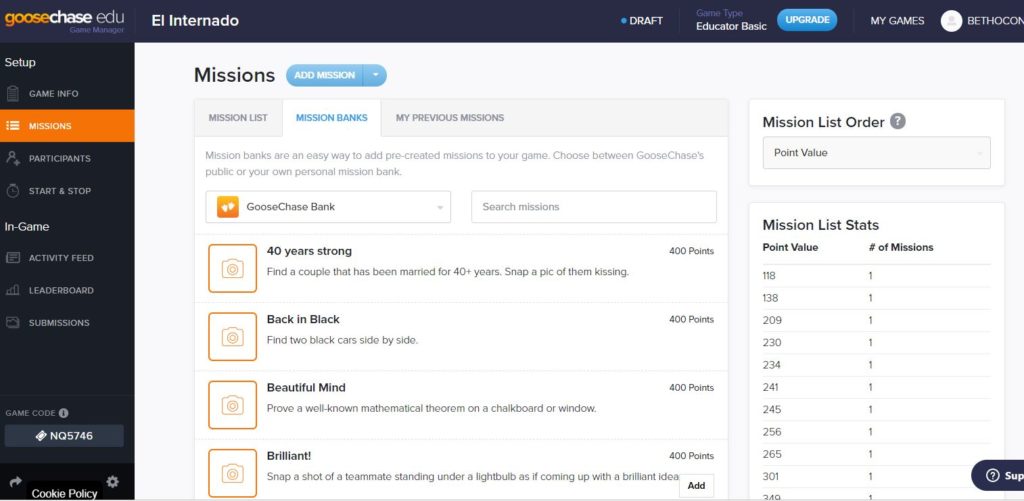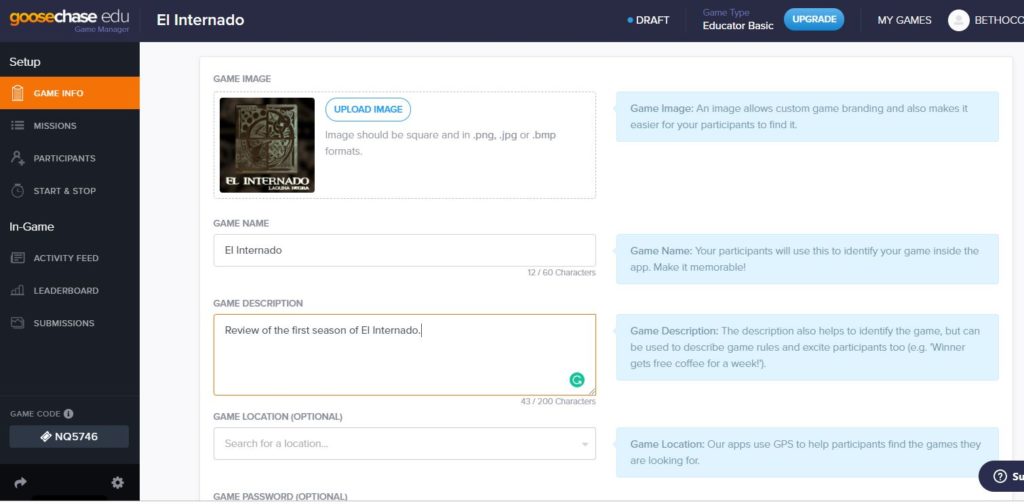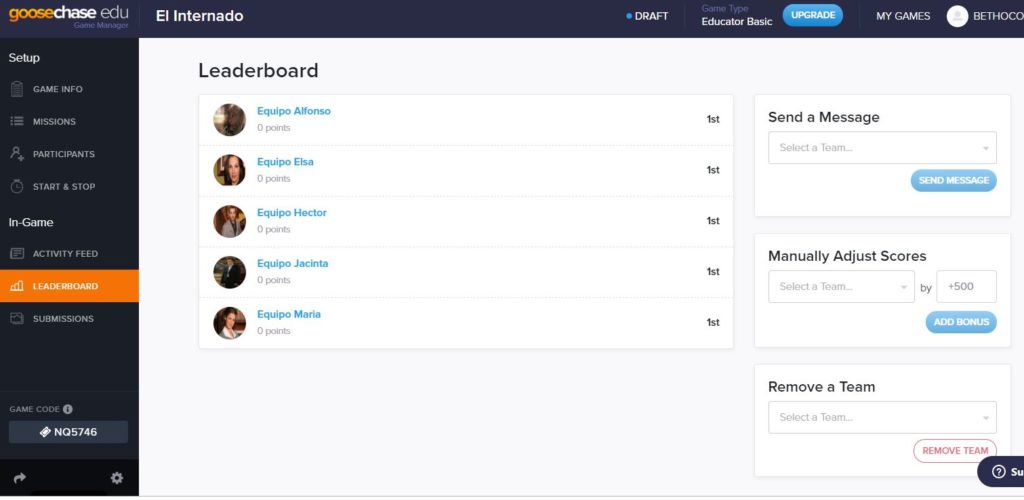GooseChase: Scavenger Hunts for Language Learning

by Beth O’Connor, Spanish Teacher, Essex High School and Vermont Virtual Learning Cooperative
DOI: https://www.doi.org/10.69732/MYRL3232
ABOUT SCAVENGER HUNTS
When I was young, the party games that were the most fun were the scavenger hunts. We were given a list of things that our team would have to find and collect. It was a creative and fun way to work with others while gathering unusual things to win the game.
Scavenger Hunts have long been a favorite activity in our country. According to Gina Wellborn in her blog Shine, they were made popular by a Gossip columnist named Elsa Maxwell in the 1930s and they have been a staple of party games ever since (Welborn and Profile n.d.). I don’t know when teachers began to use scavenger hunts in the classroom but I would imagine that they have been used by educators for decades because they are an engaging way to learn and demonstrate learning.
According to the Institute for Educational Advancement, scavenger hunts afford collaborative and hands-on learning experiences that have “numerous benefits, including the improvement of the ability to remember previously taught concepts. Scavenger hunts allow kids to practice problem-solving in a tangible way. It helps to reinforce and act-out methods they have been taught by parents or teachers in a physical way, leading to increased retention of the lessons.” They also point out the benefits of scavenger hunts for teamwork and social interaction.
Teachers have long since seen the virtue of this kind of activity both on paper as well as the more technology-aided QR Code hunts.
ABOUT GOOSECHASE
GooseChase Adventures opened in 2011 in Canada as a commercial business and brought the scavenger hunt idea to a whole new level. The company offers an app and a website interface that affords users an easy and effective way to create and host scavenger hunts. Users can leverage text, images, video and even GPS coordinates to create tasks or missions, as they are called in the app. It is clearly a high-quality product and the app and web interface work very well, with minimal glitches.
Although they offer limited free accounts, GooseChase Adventures actively seeks to sell their product to companies and other entertainment businesses. Teachers picked up this tool and began to use it in ways GooseChase had not anticipated which inspired GooseChase to build a product just for teachers.
In August of 2017, they launched GooseChase.EDU with an interface that was designed especially for educators. Teachers can use the service for free, with some manageable limitations. Free accounts can only run one live game at a time with a five-team limit. A class of 25-30 students can easily be accommodated within these boundaries.
The website makes the setup and running of the game very easy. There are libraries of games and of “missions” that can be used as-is or edited and shared with colleagues. The educational version of the app lists “missions,” links the teacher and teams via Wifi while giving students the ability to create video and photographic evidence of their hunts. This adds an element of creativity and engagement to the activity for both the creator of the hunt as well as the participants. For Modern Language teachers, this is an engaging and compelling way to provide additional input for language learners.

The mobile app provides a platform that students can use to complete the missions. Hunts can be run on field trips, in the classroom or in and around the school building. The app can use GPS coordinates which allows for place-based learning experiences. Both students and teacher can see real-time information on how and what the teams are doing. GooseChase also added a notifications feature that allows the teacher to interact with teams to provide instant feedback. All of this comes together to make for a seriously engaging activity that greatly reduces the upfront time that a teacher would need to set up a hunt “the old fashioned way.”
HOW TEACHERS ARE USING GOOSECHASE
GooseChase came to my attention through a blog post by Sharon Birch, a Spanish teacher from Maryland. She wrote about using the app to create a review of the novel, Bianca Nieves y los Siete Toritos by Carrie Toth. I was very interested since I use this novel in my classes. Ms. Birch shared how much her students enjoyed the activity: “They loved the novelty of it, the “escape” from the classroom, working with partners of their choosing, recreating what they had learned, and the competing to finish as much as possible in the time limit imposed upon them.”
GooseChase has been the subject of a number of enthusiastic blog posts by modern language teachers recently. Maris Hawkins, a Spanish teacher from Maryland, also used it to review a novel. She felt that “It gives them (students) a lot of input around the reading, and it allows them a way to visualize their learning”. Arianne Dowd, a teacher from New Jersey, writes in her blog DiscoveringCI “This app is the perfect solution to get students excited about learning again while providing them with a novel new way to review material!”
I reached out to my social media connections to find teachers who have used GooseChase.edu. I was able to find several World Language teachers willing to share their experiences with me. I also created a survey with questions for both students and teacher. The survey included the option to further contact me by phone or other means. The survey revealed that a limited number of world language teachers use GooseChase at this point. That said, current users found the tool engaging, easy to use and they highly recommended it to other teachers.
The teachers who responded to the survey reported using the tool for review or as an extension to what they are doing in the classroom. They also felt that it was an activity that should be used sparingly in order to preserve its novelty. Maris Hawkins shared that she “uses it as a review for whole class novels and designs missions requiring that students re-read portions of the novel. This follows the advice given by Bill Van Patten in his podcasts Talking L2 with BVP where he often emphasizes the benefits of re-reading.” Julie Hughes, a Spanish teacher from Kansas, likes to create Missions that require that students take a video of themselves acting out scenes from class novels. She “thinks that students love to make videos and it is better than having them speak in front of the whole class.”
Teachers pointed out that GooseChase is a great tool because it requires teamwork, positive competition, and interactivity. Well-crafted missions encourage creativity and higher-order thinking. Emily Huff, a teacher from Colorado, likes to design picture-based missions because “they can be used later to create input activities in the classroom.” All of the teachers that I contacted use the free “edu” version of the tool.
I asked the teachers I spoke to what advice they would give to their World Language colleagues interested in using the app. One teacher recommended doing a practice run with another teacher before your first GooseChase with students. It is a good idea to warn the administration and other teachers that students playing the game may be seen in the hallways or outside. Be sure to check that you have good Wifi in the areas where students will be working.
The advice and suggestions I got from these teachers confirmed that this is a valuable tool for World language classrooms. It provides yet another way to generate a context for using the language as well as a source for further input after the game. It can be an engaging way to get students to review and re-read. I would join these teachers and encourage others to try it and add it to the arsenal of tools they use in the classroom.

GOOSECHASE IN THE LANGUAGE CLASSROOM
There are many ways to use GooseChase for language learning purposes. It is an engaging way to review or supplement what you are already doing in your classroom.
Example 1 – Review and reinforce
For a novice class, I might host a game to practice descriptions of people or places in the target language. After doing a number of activities both in and out of the classroom to introduce vocabulary and structures, including a walking tour around campus to meet teachers and staff at the school, I would create a GooseChase to apply what we have learned. In this game some of the missions would include:
- matching descriptions to a series of photographs
- having to find the person from a written or recorded description and taking a selfie with that person
- drawing a picture from a description
- describing something that they need to find from a source somewhere in the school
- and taking pictures of themselves and describing the picture.
This seems like a perfect way to give students a highly engaging experience where they need to draw on what they have learned in a meaningful way.
Example 2 – Assessment
GooseChase could be used as an assessment for a unit on giving and understanding directions in a Spanish 3 class. Learners would need to follow written or oral directions to various places around the school where they would have to take a photo or do a particular task to prove that they had followed the directions correctly. Another mission could prompt them to give directions to someone else.
I think that this is the perfect tool for this type of assessment as well as a huge improvement in the execution of the activity. I have done both paper and QR code scavenger hunts for this assessment in the past. They have been very well received by students but were a lot of work for both myself and other teachers or staff around the school.
Example 3 – Improve comprehension and increase input
GooseChase can help elevate comprehension and input for a novel or story at any level as it would prompt learners to reread as much as possible. As stated by the COERLL website, “Readers learn more language and information when they engage with a text using a guided matrix or other tasks that encourage them to peruse the text again.”
After reading all or most of a novel, creating a GooseChase using well-crafted missions can get learners right back into the text to find the information or details they need to complete the tasks. Some examples might be to ask them to make video reenactments of certain scenes from the story; they can create alternative endings, either written or acted out; they can create questions for the author or for a quiz. Additionally, they can create timelines; compare characters or describe the points of view of different characters. My students love to create mimes or alternative book covers. The possibilities are endless.
Example 4 – Introduction or exploration of new material
GooseChase can also be used as an introductory tool. I thought of my Spanish 2 First Day Stations. I do this sometimes to gather information about the likes and interests of my learners as well as to introduce them to some of the fun things we are going to be doing. For the stations, I have asked learners to listen to and share music that they like; explore my Spanish reading library and tell me which books they like the most; I have them do a selfie that tells me what they are like and what they love to do; I also have them do a little Google Translation exercise to demonstrate the flaws in that tool; and they also explore the games in the room (Verba, Bananagrams, etc.). I could combine these activities into a GooseChase
GooseChase provides a leaderboard and, naturally, some students will be very focused on the point system of the game. For this reason, I would recommend carefully specifying what to include in a submission to earn all the points. Besides the issue of points, crafting good missions is also important. The teacher will need to design missions that discourage teams from merely imitating the submissions of others. The criteria should also be crafted in a way that promotes entire team participation so that teams do not split up the missions and each player only does a small portion of the tasks. If the teacher is willing to give extra points, the criteria for those points should be transparent.

CHALLENGES OF GOOSECHASE ADOPTION
GooseChase, by all accounts, can be a great tool for learning and assessing. There are, however, a few things that a teacher needs to consider before hosting a game.
The implementation of the game will only work with a good internet connection, either wifi or cellular. The teacher should know what devices their students will be using during the game and check to make sure that they have good reception. They may need to have students turn off cellular service to be sure that students don’t accidentally use their data.
The teacher will want to monitor the submissions and award points or send notifications to the teams during the game. The teacher interface during the game works better on a laptop or desktop than on the mobile app. If during a game, students need to move to areas away from the teacher’s direct supervision, the teacher will need to seek adult volunteers to help, especially when younger students are involved.
When creating a GooseChase, you can write your own missions or use the library of missions that you can copy and customize. The library of missions is as extensive or user-friendly as it could be yet. There does not seem to be a way to tag the missions which makes the search process difficult. The company is working on improving the search feature.
Teachers would also like to see more interactivity between the host and the players. While the teacher can send notifications to the students during the game, students need to be trained to make sure to see them. Maris Hawkins suggested encouraging students to interact with the host during play in exchange for extra points. They would also like to see a simple voice recording capability as a submission and a way to have students create missions or entire games themselves.
One of the benefits of the tool also can present a problem. Both the host and other teams can view the submissions in real time. This allows the host to reject a submission if it is not correct and even to make suggestions about improvements. Other teams may just copy what others did instead of having to figure it out for themselves so missions have to be thoughtfully designed to discourage this behavior.
FUTURE DEVELOPMENTS OF GOOSECHASE
For a little over a decade, I have been seen a number of websites and tools come and go. I think that one of the problems that many of them face is finding ways to stay financially viable. I believe GooseChase will be able to continue to offer free teacher accounts since it derives most of its revenue from its business accounts. Additionally, as with all technology, the early adopters have endorsed it and are spreading the word. I think that the company can expect that many more teachers will be signing up for accounts in the coming years and many more students will be enjoying the benefits of this well-designed tool. I would love to hear the many ways you have used GooseChase in your classroom, please share your experience in the comments.
References
Birch, Sharon (2017, July 17). GooseChase: A Scavenger Hunt for Today’s World. Retrieved from https://elmundodebirch.wordpress.com/2017/07/17/goosechase-a-scavenger-hunt-for-todays-world/.
Center for Open Educational Resources, and Language Learning, The University of Texas at Austin. n.d. “The Importance of Rereading | Foreign Language Teaching Methods: Reading.” Accessed March 23, 2019. Retrieved from https://coerll.utexas.edu/methods/modules/reading/03/
Dowd, Arianne (2017, May 7). GooseChase: Another Way to Techify a Novel! Retrieved from https://discoveringci.wordpress.com/2017/05/07/goosechase-another-way-to-techify-a-novel/
Everson, Phil. 2017 (2017, August 2). Introducing GooseChase EDU. GooseChase Adventures. Retrieved from https://www.goosechase.com/blog/introducing-goosechase-edu/
Hawkins, Maris (2017, May 4). GooseChase: Try It TODAY!” Retrieved from https://marishawkins.wordpress.com/2017/05/04/goosechase-try-it-today/
LaChance, Nicole (2016, May 24). Benefits of Scavenger. Institute for Educational Advancement. Retrieved from https://educationaladvancement.org/benefits-scavenger-hunts
Vecchiarelli, Jennifer (2017, May 24). Students ‘Find’ Learning Fun on Scavenger Hunts.” Retrieved from https://proliteracy.org/Blogs/Article/216/Students-Find-Learning-Fun-on-Scavenger-Hunts
Welborn, Gina (2014, June 10). History of Scavenger Hunts. Retrieved from http://ginawelborn.blogspot.com/2014/06/history-of-scavenger-hunts.html

